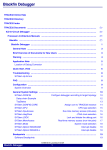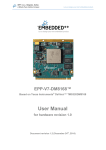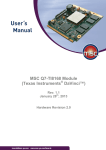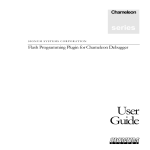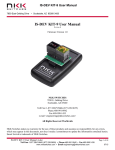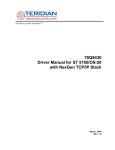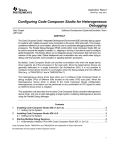Download User's Guide Iso
Transcript
SAU510-USB ISO PLUS JTAG Emulator User’s Guide Sauris GmbH Rev. A. May 2009 IMPORTANT NOTICE Sauris GmbH reserves the right to make changes to its products or to discontinue any product or service without notice, and advises its customers to obtain the latest version of relevant information to verify, before placing orders, that the information being relied on is current. Sauris GmbH warrants performance of its products and related software to current specifications in accordance with our standard warranty. Testing and other quality control techniques are utilized to the extent deemed necessary to support this warranty. Please be aware that the products described herein are not intended for use in life-support appliances, devices, or systems. Sauris GmbH assumes no liability for applications assistance, customer product design, software performance, or infringement of patents or services described herein. Nor does Sauris GmbH warrant or represent any license, either express or implied, is granted under any patent right, copyright, or other intellectual property right of Sauris GmbH covering or relating to any combination, machine, or process in which such Digital Signal Processing development products or services might be or are used. WARNING This equipment is to be used in laboratory facilities only. It generates, uses, and can radiate electromagnetic energy and has not been tested for compliance with the limits of computing devices according to clause J, part 15, FCC rules, that are designed to specify the acceptable level of electromagnetic interference. Operation of this equipment may cause radio interference. TRADEMARKS Windows 98, Windows 2000, Windows XP and Windows Vista are registered trademarks of Microsoft Corp. Code Composer and Code Composer Studio are registered trademarks of Texas Instruments. Copyright © 2009 Sauris GmbH. Dear developers! 1. Sauris GmbH pleased to recommend you ask your technical questions on our forum. You can find answers to your questions on the forum pages and add a new topic to discuss the problem with our engineers. 2. We suggest you to read WiKi, where you can find the full description of the functionality of our products. Please register and ask your question. Please, don't forget to subscribe to new topics to keep track of the status of your question. You will be informed by e-mail when our engineers respond to the message. 3. Dear Friends, you could join projects support program right now sending us RFQ, Technical Questions or Samples Order. Also you can find warranty terms on our web. User’s Guide 2 Sauris GmbH Contents 1 Introduction to SAU510-USB ISO PLUS JTAG Emulator.......................................... 4 1.1 Overview of SAU510-USB ISO PLUS JTAG Emulator .................................. 4 1.2 Key Features of SAU510-USB PLUS JTAG Emulator .................................... 4 1.3 Key Items of SAU510-USB PLUS JTAG Emulator........................................ 5 2 Plugging SAU510-USB ISO PLUS JTAG Emulator................................................... 6 2.1 Equipment required .............................................. .......................................... 6 2.2 Connecting SAU510-USB ISO PLUS JTAG Emulator.................................... 6 2.3 SAU510-USB ISO PLUS LEDs ........................... .......................................... 7 3 Specifications for Your Target System’s Connection to the Emulator ......................... 8 3.1 Designing Your Target System’s JTAG Connector (14-pin Header) ................ 8 3.2 Bus Protocol......................................................... ........................................ 10 3.3 Emulator Cable Pod Logic.................................... ........................................ 11 3.4 Emulator Cable Pod Signal Timing....................... ........................................ 11 3.5 Buffering Signals Between the Emulator and the Target System.................... 12 3.6 JTAG-connection settings..................................... ........................................ 15 About This Manual This manual describes SAU510-USB PLUS JTAG emulator that is designed to be used in combination with digital signal processors (DSPs) and microcontrollers manufactured by Texas Instruments Incorporated (TI). SAU510-USB PLUS JTAG Emulator is a portable table top device that is attached to a personal computer or a laptop and allows to develop and debug applications based on DSPs and microcontrollers from TI. Related Documents Code Composer Studio IDE v3.1 Getting Started Guide (SPRU509) Code Composer Studio™ IDE v.3 White Paper (SPRAA08) User’s Guide 3 Sauris GmbH 1 Introduction to SAU510-USB ISO PLUS JTAG Emulator This chapter provides a description of SAU510-USB PLUS JTAG Emulator and its key features. 1.1 Overview of SAU510-USB ISO PLUS JTAG Emulator SAU510-USB ISO PLUS JTAG Emulator was designed to be used with digital signal processors (DSPs) and microprocessors that are connected through JTAG. The Emulator supports connection through JTAG at the levels of +1.65 … +5 volt. The Emulator is connected to a PC using USBinterface and draws no power from the target system. Figure 1-1 shows the delivery set of SAU510-USB ISO PLUS JTAG Emulator. Figure 1-1. Delivery set of SAU510-USB ISO PLUS JTAG Emulator SAU510-USB ISO PLUS was designed to be compatible with the existing debuggers provided by Texas Instruments. 1.2 Key Features of SAU510-USB PLUS JTAG Emulator SAU510-USB ISO PLUS JTAG Emulator has the following features: • Supports Texas Instrument’s Digital Signal Processors (C2000, C5000, C6000, DaVinciTM, OMAPTM) and TMS470R1x 16/32-bit RISC Microcontrollers with JTAG interface (IEEE 1149.1) from Texas Instruments • Compatible with Texas Instrument’s XDS510 emulator • Provides voltage isolation 2500VRMS between PC and target • Advanced emulation controller enables high performance • Compatible with USB 1.1 and USB 2.0 (high speed/full speed) • Supports USB interface with host PC, requires no additional adapter card • Supports from +1.65 volt up to +5 volt JTAG interfaces User’s Guide 4 Sauris GmbH • • • • • 1.3 Three Status Light Emitting Diodes (LEDs) show operational status Power provided by host USB port or USB hub Supports programming and configuring FPGA and CPLD through SVF player (SVF Specification Rev.E + Lattice Semiconductor enhancements). Compatible with Texas Instruments Code Composer Studio IDE Compatible with Windows 2000, Windows XP and Window Vista (32-bit) Operating Systems Key Items of SAU510-USB PLUS JTAG Emulator Figure 1-2 shows SAU510-USB PLUS. The key items are: • Status LEDs • 7x2 JTAG connector(IDC14, step 2.54 mm) • Tail • mini-USB connector to a host PC or a hub Figure 1-2. SAU510-USB PLUS JTAG Emulator User’s Guide 5 Sauris GmbH 2 Plugging SAU510-USB ISO PLUS JTAG Emulator This chapter helps you to plug SAU510-USB PLUS JTAG Emulator into your system. Note: you should have Code Composer Studio installed before installing SAU510-USB ISO PLUS. In order to use specific software packages such as the Code Composer Studio from TI refer to the manufacturer’s documentation. 2.1 Equipment required The checklists below include the items that are presented in SAU510-USB ISO PLUS JTAG emulator delivery set and additional items you will need. Hardware checklist o Host: any PC or laptop with a hard-disk system and a USB port and a CD-ROM disk drive o Memory: minimum of 32MB o Display: color VGA or LCD o Emulator: SAU510-USB ISO PLUS JTAG emulator o Target system: any TI DSP-based or TI Microcontroller-based board with power supply o Connectors: 14-pin connector (two rows of seven pins), 20-pin connector ARM JTAG or 20-pin CTI JTAG.See Section 3 for more information on connecting to target system Software checklist o Operating system: Windows 2000, Windows XP or Windows Vista (32-bit) o Software tools: Code Composer Studio o Drivers: Sauris GmbH drivers for TI Code Composer Studio (are included into SAU510-USB ISO PLUS JTAG emulator delivery set and are also available at Sauris GmbH website – www.sauris.de) 2.2 Connecting SAU510-USB ISO PLUS JTAG Emulator Follow the steps in this section to plug SAU510-USB ISO PLUS JTAG Emulator in your PC and target board. Figure 2-1 shows SAU510-USB ISO PLUS connected to a target system and a PC. Figure 2-1. Connecting SAU510-USB ISO PLUS to target system and PC Follow these steps to connect SAU510-USB PLUS JTAG emulator: 1 Insert the Sauris GmbH USB Driver CD in the computer CD-ROM drive User’s Guide 6 Sauris GmbH 2 3 4 5 6 7 8 9 Turn off all antivirus software on your PC Run sau510usb_install.exe from the driver CD and follow the instructions on the screen Turn on the antivirus software if needed Connect the USB cable to your SAU510-USB ISO PLUS JTAG emulator. After a while Windows will detect a new hardware and prompt you with New Hardware Found screen. If you want to verify the USB driver installation has been successful, right click Control Panel and select PropertiesàHardwareàDevice Manager. You should see a new class JTAG Emulator and one emulator (SAU510-USB v.2 (Iso) JTAG emulator) installed. Detach the USB cable from SAU510-USB PLUS JTAG emulator. Connect the emulator to the JTAG on your target board. Apply power to the target board. Connect the USB-cable to SAU510-USB PLUS JTAG emulator. In future, after the drivers are installed, follow these steps to connect SAU510-USB ISO PLUS JTAG emulator: 1 Turn off the power supply of your target board. 2 Connect the emulator to the JTAG on your target board 3 Apply power to the target board. 4 Connect the USB-cable to SAU510-USB ISO PLUS JTAG emulator. Detach SAU510-USB PLUS JTAG emulator in the reverse order: 1 Detach the USB cable from SAU510-USB ISO PLUS JTAG emulator. 2 Turn off the power supply of your target board. 3 Detach the emulator from the JTAG on your target board Note: Be very careful with the target cable connectors. Connect them gently; do not force them into position, or you may damage the connectors. 2.3 SAU510-USB ISO PLUS LEDs SAU510-USB ISO PLUS has three LEDs. The LEDs inform the user of the emulator status. The meaning of the LEDs is described in the table below. LED PWR ACT STT User’s Guide Description Indicates emulator power Green – power from USB. Red – power from target. Blink red – there is no TCKR signal with power from target and turn off without TCKR mode. Activity through JTAG interface Green – data between emulator and PC Red – TRST signal active State of JTAG No light - TEST-LOGIC-RESET Green – RUN-TEST/IDLE Red – SHIFT-IR or PAUSE-IR Green+Red - SHIFT-DR или PAUSE-DR 7 Sauris GmbH 3 Specifications for Your Target System’s Connection to the Emulator This chapter contains the information on connecting your target system to the emulator. Your target system must have a special 14-pin connector JTAG, 20-pin ARM JTAG or 20-pin CTI JTAG for proper communication with the emulator. NOTE: emulator outputs voltage level correspond to PD voltage on 1.65 to 5 V 3.1 Designing Your Target System’s JTAG Connector The emulator is connected to target systems through a dedicated port. The port supports IEEE 1149.1 (JTAG) standard and is accessible through the emulator. The board is to have a 20-pin header (2 rows of 7 pins), 20-pin ARM header or 20-pin CTI header in order to communicate with the emulator. 3.1.1 14-pin JTAG description The pin assignment scheme is shown in Figure 3-1. And the emulation signals are described in Table 1. TMS 1 2 TRST- TDI 3 4 GND PD(Vcc) 5 6 No pin (key) TDO 7 8 GND TCK_RET 9 10 GND TCK 11 12 GND EMU0 13 14 EMU1 Figure 3-1. 14-pin JTAG Connector Table 1. 14-Pin Header Signal Description Pin # 1 2 3 5 Signal TMS TRSTTDI PD 7 9 TDO TCK_RET 11 TCK 13 14 EMU0 EMU1 User’s Guide Description JTAG test mode selection JTAG test reset JTAG test data input. Power detect. Indicates power and voltage levels on JTAG signal circuits. It should be connected to target JTAG I/O buffers. JTAG test data output. JTAG test clock return. Test clock input to the emulator. May be a buffered or unbuffered version of TCK. JTAG test clock. TCK is a 12-MHz clock source from the emulation pod. This signal can be used to drive the system test clock. Emulation pin 0. Emulation pin 1. Emulator State Output Output Output Input Target State Input Input Input Output Input Input Output Output Output Input Input/Output Input/Output Input/Output Input/Output 8 Sauris GmbH 3.1.2 20-pin ARM JTAG description The pin assignment scheme is shown in Figure 3-2. And the emulation signals are described in Table 2. VTref 1 2 NC nTRST 3 4 GND TDI 5 6 GND TMS 7 8 GND TCK 9 10 GND RTCK 11 12 GND TDO 13 14 GND RESET 15 16 GND DBGRQ 17 18 GND 5V-Supply 19 20 GND Figure 3-2. 20-pin ARM JTAG Connector Table 2. 20-Pin ARM Header Signal Description Pin # 1 Signal VTref 2 3 5 7 9 11 13 15 17 19 NC nTRST TDI TMS TCK RTCK TDO RESET DBGRQ 5V-Supply User’s Guide Description Power detect. Indicates power and voltage levels on JTAG signal circuits. It should be connected to target JTAG I/O buffers. This pin is not connected JTAG Reset JTAG data input of the target CPU JTAG mode set input of the target CPU JTAG clock signal to target CPU. Return test clock signal from the target JTAG data output from the target CPU. Target CPU reset signal This pin is not connected. Received This pin can be used to supply power to the target hardware Emulator State Input Target State Output NC Output Output Output Output Input Input Input/Output NC Output NC Input Input Input Input Output Output Input/Output NC Input 9 Sauris GmbH 3.1.3 20-pin CTI JTAG description The pin assignment scheme is shown in Figure 3-3. And the emulation signals are described in Table 3. TMS 1 2 TRST- TDI 3 4 GND PD 5 6 No pin (key) TDO 7 8 GND TCK_RET 9 10 GND TCK 11 12 GND EMU0 13 14 EMU1 SRST 15 16 GND EMU2 17 18 EMU3 EMU4 19 20 GND Figure 3-3. 20-pin CTI JTAG Connector Table 3. 20-Pin CTI Header Signal Description Pin # 1 2 3 5 Signal TMS TRSTTDI PD 7 9 TDO TCK_RET 11 TCK 13 14 15 EMU0 EMU1 SRST 17 18 19 EMU2 EMU3 EMU4 3.2 Description JTAG test mode selection JTAG test reset JTAG test data input. Power detect. Indicates power and voltage levels on JTAG signal circuits. It should be connected to target JTAG I/O buffers. JTAG test data output. JTAG test clock return. Test clock input to the emulator. May be a buffered or unbuffered version of TCK. JTAG test clock. TCK is a 12-MHz clock source from the emulation pod. This signal can be used to drive the system test clock. Emulation pin 0. Emulation pin 1. This is the target reference voltage. It is used to check if the target has power, to create the logic-level reference for the input comparators and to control the output logic levels to the target. It is normally fed from Vdd of the target board and must not have a series resistor. This pin is not connected JTAG Reset JTAG data input of the target CPU Emulator State Output Output Output Input Target State Input Input Input Output Input Input Output Output Output Input Input/Output Input/Output Input/Output Input/Output Input/Output Open drain Input/Output Input/Output Input/Output Input/Output Input/Output Input/Output Bus Protocol The IEEE 1149.1 specification covers the requirements for JTAG bus of the target devices (such as the TMS320C6000 family) and provides certain rules summarized as follows: User’s Guide 10 Sauris GmbH § The TMS/TDI inputs are sampled on the rising edge of the device TCK signal. § The TDO output is clocked from the falling edge of the device TCK signal. When JTAG devices are daisy-chained together, the TDO from each of the devices in the chain has a definite period in the TCK cycle. Such synchronization scheme allows to distinguish the data from different target devices included into the same chain. The penalty for this timing scheme is a reduced TCK frequency. The IEEE 1149.1 specification does not provide rules for JTAG bus master devices (e.g. emulator). 3.3 Emulator Cable Pod Logic Figure 3-4 shows the JTAG connector of the emulator cable. Here are the key features of JTAG interface: • TMS and TDI signals are generated from the rising edge of TCK_RET, on default (but the standard can be adjusted in the configuration file). • The edges of TMS, TDI, TCK and TRST signals do not coincide in order to reduce signal echo. • TCK equals 25-MHz on default. You may also set another level of TCK. Figure 3-4. Emulator Pod Connector 3.4 Emulator Cable Pod Signal Timing Figure 3-5 shows the clock signal timings for the emulator. Table 4 defines the timing parameters for the emulator. The timing parameters are for reference only, Sauris GmbH does not test them or guarantee their coincidence with the given in the table. The emulator pod uses TCK_RET as its clock source for internal synchronization. TCK can also be used as an optional test clock source for the target system. Figure 3-5. Signal Timings for the Emulator Table 4. Emulator Pod Timing Parameters User’s Guide 11 Sauris GmbH * No 1 Reference tTCKmin 2 tTCKhighmin 3 tTCKlowmin 4 td(XTMX) 5 tsu(XTDOmin) 6 thd(XTDOmin) Description TCK_RET period TCK_RET high pulse duration TCK_RET low pulse duration TMS/TDI setting time after TCK_RET edge* TDO setup time to TCK_RET high TDO hold time from TCK_RET high Min 30 Max 18.5 Units ns 12 8 ns 12 8 ns 8 17.5 ns 1.9 ns 0.6 ns from positive edge of TCK_RET (if POD_TDOONTCKFALL=NO) and from negative edge of TMS/TDI (if POD_TDOONTCKFALL=YES). TMS/TDI delay sets by POD_TMS_OFS and POD_TDO_OFS parameters. 3.5 Buffering Signals Between the Emulator and the Target System It is extremely important to provide high-quality signals between the emulator and the target system, especially the processor TCK and the emulator TCK_RET signals. In some cases this may require special PCB trace routing and using termination resistors to match the trace impedance. If the distance between the emulation header and the target device is longer than 15 cm, the emulation signals must be buffered. The need for signal buffering can be divided in two cases: • No signal buffering. As shown in figure 3-6, the distance between the header and the target device does not exceed 15 cm. Figure 3-6. No Signal Buffering • Buffered emulation signals. Figure 3-7 shows that the distance between the emulation header and the target device is longer than 15 cm. The target device signals TMS, TDI, TDO, and TCK_RET are buffered through several additional units. User’s Guide 12 Sauris GmbH Figure 3-7. Buffered Emulation Signals The EMU0 and EMU1 signals must have pull-ups to Vcc. The signal rise time of the pull-up resistors should be less than 10 μS. A 4.7k Ω resistor is suggested for most applications. EMU0-1 are I/O pins of the target device, however, they are inputs for the emulator only. These pins are used in multiprocessor systems to provide run/stop operations. The emulator pod enables sequential termination of the TMS, TCK, and TDI signals. Figure 3-8 shows an application with the system test clock generated in the target system. The TCK signal is left unconnected in this application. There are two reasons for having the target system generating the test clock: o The emulator provides a 25-MHz test clock on default (the actual value can be adjusted in the configuration file). When using the target system test clock you can set the frequency to match your system requirements. o Sometimes the test clock is required when the Emulator is switched off. Figure 3-8. Target System Generates Test Clock Figure 3-9 shows a typical multiprocessor configuration. This is a daisy chained configuration (TDOTDI daisy-chained), that meets the minimum requirements of the IEEE 1149.1 specification. The emulation signals in this example are buffered to isolate the processors from the emulator and provide adequate control signal for the target system. One of JTAG test interface benefits is that you can slow down the test clock to eliminate timing problems. Multiprocessor systems should meet the following requirements: o The processor TMS, TDI, TDO and TCK signals are to be buffered to control timing skew better. User’s Guide 13 Sauris GmbH o The input buffers for TMS, TDI, and TCK should have pull-ups to Vcc. This will hold these signals at a required value if the emulator is switched off. A pull-up resistor of 4.7k Ω is suggested for most applications. Figure 3-9. Multiprocessor Connections User’s Guide 14 Sauris GmbH 3.6 JTAG-connection settings Here you will find the description of the parameters that are set in the configuration file. The template of the configuration file will appear in the directory «<CCS_Install_Dir>/cc/bin/BrdDat» named «sm510usb.cfg» after the drivers installation. It is a text file in which you can set different parameters and modes for the correct device operating. 3.6.1 Parameters for connection several emulators to one PC Parameters format: [PARAMETER_NAME] value PARAMETER_NAME – parameter name value – parameter value The parameter value may be either YES/NO or a number, or a line taken into apostrophes (‘). If you use Code Composer Studio v.2 Set the parameters in the configuration file which you are going to use in the connection. [POD_SN] value [POD_PORT] value Value is the serial number of the Emulator that will use the current configuration file for the connection. These parameters are commented on default – it means that the connection is performed through the first Emulator found by the system. To activate the parameters, please uncomment them (delete the symbol “;” before the parameter). Both of these parameters are to have the same value (the serial number of the Emulator). The leading zeros are allowed but are not required. User’s Guide 15 Sauris GmbH If you use Code Composer Studio v.3 If you create the connection using configuration file do all as described for the Code composer Studio v.2. If you create the connection through “Factory Board” based on SAU510USB Iso or through “Create Board” using Sauris SAU510-USB Iso Plus Emulator, then you should select tab “Connections Properties” and set YES in the “Use specified emulator only” parameter. After that you should enter the values into the “Enter Serial Number” and “Enter Serial Number again” fields. User’s Guide 16 Sauris GmbH If you use Code Composer Studio v.4 Select the “Advanced” tab in the “Target Configuration” editor. Select the connection. After that “Connections Properties” will appear on the right side. Set the parameter “Use specified emulator only” and after that enter the values into the “Enter Serial Number” and “Enter Serial Number again” fields. 3.6.2 Parameters for setting TCK frequency [POD_TCKDIV] value [POD_TCKEXP] value [POD_TCKPREDIVENA] YES/NO [UNIFY_CLKMODE] ‘slow’/’fast’/’normal’ There are two ways to enable the clocking of the JTAG-chain. These are clocking at a fixed frequency and adaptive clocking. The fixed frequency can be used for most hardware where the maximum allowed TCK does not depend on the CPU frequency. The adaptive clocking is used for the devices that require dynamically changing TCK for operating – in these devices the TCK is based on the clock frequency of the CPU. DaVinci is an example of such a device – it includes ARM- and DSP-cores that have different clock frequency and the TCK in each moment depends on the frequency of the currently active core. To setting frequency in the CCS v.2 or CCS v.3 if you create the connection using configuration file set the [POD_TCKDIV], [POD_TCKEXP] and [POD_TCKPREDIVENA] parameters in the *.cfg file. Range of the parameters: [POD_TCKEXP] 0…7 [POD_TCKDIV] 0…15 [POD_TCKPREDIVENA] YES/NO If POD_TCKEXP = 0 then Ftck = 210 / (POD_TCKDIV + 4) MHz If POD_TCKEXP > 0 then Ftck = 210 / ((POD_TCKDIV + 1) * (2^POD_TCKEXP) + 4) MHz To initiate the additional frequency divider set YES in the [POD_TCKPREDIVENA] parameter. User’s Guide 17 Sauris GmbH You can use the frequency from 25 kHz to 52.5 MHz. [UNIFY_CLKMODE] should be set as slow for the TCKs of 500 kHz and lower. [UNIFY_CLKMODE] should be set as fast for the TCKs of 5 MHz and higher. To set the TCK in the CCS v.3 by creating the connection through “Factory Board” based on SAU510USB Iso or through “Create Board” using Sauris SAU510-USB Iso Plus Emulator, then you should select tab “Connections Properties” and set TCK Frequency Divider range and ЕСЛ Frequency. Additionally you can initiate the additional frequency divider by setting “Enable additional 4x TCK divider” parameter. 3.6.3 Adaptive clocking mode [POD_ACLK_ENABLE] YES/NO On default TCK is generates by emulator independently of TCKR from target. There is a constant frequency on TCK. But some processors is needed in frequency limit, that should be set inside and depended from its own clock frequency that can be considerably change during the functioning, for example because of PLL reprogramming. This processors have JTAG return clock frequency output gated required internal frequency. If this output connected to emulator’s TCKR, then adaptive clocking mode allows emulator to function on maximum frequency, that is allowed to processor. In the adaptive clocking mode it is required not only TCK signal, but correspondence TCKR with current TCK value, for generating TCK edge. Thus never be generated rising or falling edge before previous rising/falling edge did not go through TCK->TCKR circuit. In this case maximum frequency is limited by divider. As a rule adaptive clocking mode is used with ARM processors. Note: It is dangerous to set TCK frequency limit higher than 20 MHz when adaptive clocking mode. There can be bugs of emulator-target system if as a result of adaptation “tweaking connection for functioning on high frequency” requirements is changed. For enable adaptive clocking in the CCS v.2 or CCS v.3 if you create the connection using configuration file set YES in the [POD_ACLK_ENABLE] parameter in the configuration file. To enable adaptive clocking in CCS v.3 by creating the connection through “Factory Board” based on SAU510USB Iso or through “Create Board” using Sauris SAU510-USB Iso Plus Emulator or in CCS v.4 you should set the “Enable adaptive clocking” parameter in the connection properties. 3.6.4 Functioning without return clocking There is some cases where system needs to functioning without return clocking signal, for example, functioning with ARM JTAG where TCKR signal is optional. There is bypass way for the signal TCK -> TCKR beside all outside circuits. This way provide approximately the same delay as outside circuit by using standard cable and 5 cm length of TCK->TCKR. There is an opportunity to increase this delay with the 4,8 ns (1/210 MHz) step. [POD_TCK_BPAS_DLY] 0..3 [POD_NO_TCKR] YES/NO [POD_TCK_BPAS_DLY] adjusts delay from zero to 3*4,8 ns. To enable functioning without return clocking mode in CCS v.2 or CCS v.3 if you create the connection using configuration file set YES in the [POD_NO_TCKR] parameter and value of the [POD_TCK_BPAS_DLY] parameter in the *cfg file. User’s Guide 18 Sauris GmbH [POD_TCK_BPAS_DLY] 0..3 [POD_TCK_BPAS_DLY] adjusts delay from zero to 3*4,8 ns. To enable functioning without return clocking mode in CCS v.3 by creating the connection through “Factory Board” based on SAU510USB Iso or through “Create Board” using Sauris SAU510USB Iso Plus Emulator or in CCS v.4 you should set “Target doesn’t provides TCKR signal” in the “TCKR signal mode” parameter. After that set the “Additional delay for internal TCKR bypass path”. 3.6.5 Control the impedance matching circuits There is an opportunity to connect the impedance matching circuits to TCK_RET and TDI pins to improve this signals quality. It connects on default. [POD_TCKLOAD] YES/NO [POD_TDILOAD] YES/NO To connect the impedance matching circuits to TCK_RET and TDI in CCS v.2 or CCS v.3 if you create the connection using configuration file set the appropriate value in the [POD_TCKLOAD] or [POD_TDILOAD] parameters in the *cfg file. Note: Signal for connection of both impedance matching circuits generates as logic function of [POD_TCKLOAD] OR [POD_TDILOAD]. To connect the impedance matching circuits to TCK_RET and TDI in CCS v.3 by creating the connection through “Factory Board” based on SAU510USB Iso or through “Create Board” using Sauris SAU510-USB Iso Plus Emulator or in CCS v.4 you should set appropriate value in “TDI and TCKR termination” parameter. 3.6.6 Tweaking connection for functioning on high frequency There is a large internal generating TMS and TDO delay relative to TCKR edge in the SAU510-USB ISO PLUS Emulator because of galvanic isolation. TMS and TDO change after 38 ns after the TCKR edge. Thus if you do not change parameters of this chapter then high TCK frequency is 24 MHz. There is an opportunity to function on higher frequencies. It is necessary when you use devices which generate its own TCKR signal which do not depends from emulator TCK (for example, some starter kits from Spectrum Digital which generates its own TCKR with 30 MHz frequency). For tweaking connection there are following parameters. [UNIFY_LINKDLY] 3..5 [POD_TMS_OFS] 0..7 [POD_TDO_OFS] 0..7 [POD_TDOONTCKFALL] YES/NO [UNIFY_LINKDLY] (“Link delay”). This parameter set number of delay cycles of TMS and TDO after its generate by JTAG-controller in the emulator and before its fall into processor pins. Minimus value is 3 because of synchrosignal into the emulator. If the delay of generating TMS and TDO from rising edge TCKR exceeds one period of TCKR you should increase parameter Link Delay on one item by setting value 4. If the delay of generating TMS and TDO from rising edge TCKR exceeds two periods of TCKR you should increase parameter Link Delay on two items by setting value 5. [POD_TMS_OFS] and [POD_TDO_OFS] (“Additional delay for TMS output”, “Additional delay for TDO output”). This parameters provide set additional delay in generating TMS and TDO form zero to 7 * 4,8 ns intervals. You should tuning this parameters if TMS and TDO disturb setup/hold User’s Guide 19 Sauris GmbH requirements for processor with defined frequency and TCKR->TMS/TDO delay. To move TMS/TDO changing you should increase parameters [POD_TMS_OFS] and [POD_TDO_OFS]. After that you should specify the “Link delay” parameter. [POD_TDOONTCKFALL] (“TMS/TDO output timing”) allows to switch the output driver of TMS and TDO to sampling at the falling edge of TCKR. It comply with the IEEE-1149.1 standard, but it enables less value of max TCK frequency (approximately 11..12 MHz) because of 38 ns delay (due to galvanic isolation) starts not from previous rising edge to next rising edge but from falling edge TCKR to rising edge. Remember that there is a frequency limit in TMS/TDO sampling at the falling edge mode when enable adaptive clocking mode. You can use this parameter to solve the problems with setup/hold requirements. Enabling the TMS/TDO sampling at the falling edge mode generates half period delay of TCKR relative to sampling at the rising edge mode. Note: if the divide coefficient is odd then width of positive half-wave differ from negative halfwave on 4,8 ns. Half-wave width can be unpredictable in the adaptive clocking mode. User’s Guide 20 Sauris GmbH IMPORTANT NOTICE Sauris GmbH and its subsidiaries (Sauris) reserve the right to make corrections, modifications, enhancements, improvements, and other changes to its products and services at any time and to discontinue any product or service without notice. Customers should obtain the latest relevant information before placing orders and should verify that such information is current and complete. All products are sold subject to Sauris’s terms and conditions of sale provided at the time of order acknowledgment. Sauris warrants performance of its hardware products to the specifications applicable at the time of sale in accordance with Sauris’s standard warranty. Testing and other quality control techniques are used to the extent Sauris deems necessary to support this warranty. Except where mandated by government requirements, testing of all parameters of each product is not necessarily performed. Sauris assumes no liability for applications assistance or customer product design. Customers are responsible for their products and applications using Sauris devices. To minimize the risks associated with customer products and applications, customers should provide adequate design and operating safeguards. Sauris does not warrant or represent that any license, either express or implied, is granted under any Sauris patent right, copyright, or other Sauris intellectual property right relating to any combination, machine, or process in which Sauris products or services are used. Information published by Sauris regarding third–party products or services does not constitute a license from Sauris to use such products or services or a warranty or endorsement thereof. Use of such information may require a license from a third party under the patents or other intellectual property of the third party, or a license from Sauris under the patents or other intellectual property of Sauris. Reproduction of information in Sauris data books is permissible only if reproduction is without alteration and is accompanied by all associated warranties, conditions, limitations, and notices. Reproduction of this information with alteration is an unfair and deceptive business practice. Sauris is not responsible or liable for such altered documentation. Resale of Sauris products or services with statements different from or beyond the parameters stated by Sauris for that product or service voids all express and any implied warranties for the associated Sauris product or service and is an unfair and deceptive business practice. Sauris is not responsible or liable for any such statements. Mailing Address: Sauris GmbH Volkartstr. 75 80636 Munich, Deutschland Copyright © 2002-2009 «Sauris GmbH» User’s Guide 21























